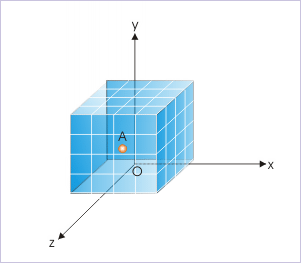| << Chapter < Page | Chapter >> Page > |
Coordinate system is a system of measurement of distance and direction with respect to rigid bodies. Structurally, it comprises of coordinates and a reference point, usually the origin of the coordinate system. The coordinates primarily serve the purpose of reference for the direction of motion, while origin serves the purpose of reference for the magnitude of motion.
Measurements of magnitude and direction allow us to locate a position of a point in terms of measurable quantities like linear distances or angles or their combinations. With these measurements, it is possible to locate a point in the spatial extent of the coordinate system. The point may lie anywhere in the spatial (volumetric) extent defined by the rectangular axes as shown in the figure. (Note : The point, in the figure, is shown as small sphere for visual emphasis only)
A point in the coordinate system

A distance in the coordinate system is measured with a standard rigid linear length like that of a “meter” or a “foot”. A distance of 5 meters, for example, is 5 times the length of the standard length of a meter. On the other hand, an angle is defined as a ratio of lengths and is dimensional-less. Hence, measurement of direction is indirectly equivalent to the measurement of distances only.
The coordinate system represents the system of rigid body like earth, which is embodied by an observer, making measurements. Since measurements are implemented by the observer, they (the measurements in the coordinate system) represent distance and direction as seen by the observer. It is, therefore, clearly implied that measurements in the coordinates system are specific to the state of motion of the coordinate system.
In a plane language, we can say that the description of motion is specific to a system of rigid bodies, which involves measurement of distance and direction. The measurements are done, using standards of length, by an observer, who is at rest with the system of rigid bodies. The observer makes use of a coordinate system attached to the system of rigid bodies and uses the same as reference to make measurements.
It is apparent that the terms “system of rigid bodies”, “observer” and “coordinate system” etc. are similar in meaning; all of which conveys a system of reference for carrying out measurements to describe motion. We sum up the discussion thus far as :

Notification Switch
Would you like to follow the 'Physics for k-12' conversation and receive update notifications?